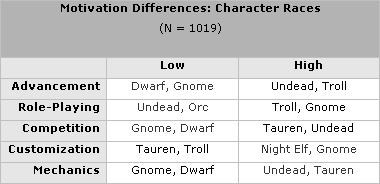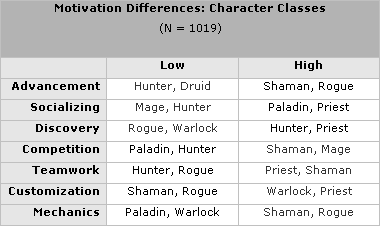July 28, 2005
PlayOn Census Data
Imagine if we could take a census of WoW every 15 minutes and build longitudinal profiles of players. The resulting data set would let us answer many interesting questions. Do certain classes level faster than others? How long does it take on average to get to level 60? Do characters in guilds spend more time playing the game than characters not in guilds.
This is the data set that a group at PARC has been gathering and analyzing. Weíve gathered data from over 70,000 characters and are presenting some of the findings at the PlayOn Blog. If you like numbers, charts, and stats, youíll enjoy going through the findings that have accumulated. Here are some quick highlight pointers to get you started exploring the data:
1) It takes on average 20 full days of playing time for a character to get from level 1 to level 60. Thatís 60 full work-days or 3 full work months (since weíd get weekends off in a work month).
2) Druids and Paladins are the slowest levelers. Shamans, Rogues, Mages, and Priests are the fastest levelers.
3) Characters in guilds do not spend more time playing each week than characters not in guilds.
4) Characters in guilds do not level faster than characters not in guilds.
5) Warlocks and Hunters are least likely to be grouped. Priests and Druids are most likely to be grouped.
WoW Gender-Bending
23% of male players (N = 939) listed a character of the opposite gender as their most enjoyable character compared with 3% of female players (N = 184). In WoW, men are about 7-8 times as likely to gender-bend than women.
Given a hypothetical pool of 1000 players:
840 would be male players
160 would be female players
Of the 840 male players:
193 would be playing a female character
647 would be playing a male character
Of the 160 female players:
5 would be playing a male character
155 would be playing a female character
Thus, altogether there are 348 female characters of which 193 (55%) would be played by a male player.
And there are 652 male characters of which 5 (< 1%) would be played by a female player.
In other words:
about 1 out of every 2 female characters is played by a man
about 1 out of every 100 male characters is played by a woman
The RL gender distribution is 84% male vs. 16% female.
The in-game gender distribution is 65% male vs. 35% female.
Men over the age of 18 are more likely to gender-bend (25%) than men under the age of 18 (10%). Players who gender-bend score significantly higher on the Customization and Mechanics motivations than players who do not gender-bend. In other words, the two primary reasons why players gender-bend are to be able to be more stylish and to optimize their character (via gifts?).
WoW Character Race Demographics
Younger players tend to prefer being Trolls and Undead, while older players prefer being Orcs and Dwarfs. Interestingly, 3 Horde races have the lowest average age - Orc being the exception.

Night-Elves and Gnomes significantly more likely to be played by a female player. Orcs and the Undead are more likely to be played by a male player.

An overview of the motivation differences among players who prefer different character classes is shown below, followed by the detailed charts for each motivation. Only those motivations that were significant in an ANOVA are listed. Whatís interesting is the repeated differences between the Gnome/Dwarf vs. the Undead/Tauren.
Click here for an overview of the motivations framework.

====





WoW Character Class Demographics
Exploring the RL demographic and motivational differences in terms of character class selection has typically been difficult due to within-class variations among contemporary MMOs. For example, there is no easy way to classify character classes in Star Wars Galaxies or City of Heroes due to the extensive class combination possibilities. WoW, on the other hand, provides a clean class categorization. While there are still within-class variations, they are minimal compared with SWG/CoH variations.
From the survey data, there are significant age differences among players who prefer different character classes. Players who prefer Rogues and Shamans tend to be younger than players who prefer Warlocks and Hunters.

Female players are more likely to prefer Priests, Hunters, and Druids, while male players are more likely to prefer Rogues, Warriors, and Shamans.

An overview of the motivational difference is presented here. Only the motivations where an ANOVA showed significant differences among the character classes are listed. The detailed charts for each motivation follow. The motivational differences among the different character classes highlights an interesting potential effect of balancing classes. Given that classes do not appeal to players equally, nerfing or strengthening a class would have the effect of driving away or attracting players with different motivations.
Click here for an overview of the motivations framework.

====







WoW Alliance vs. Horde
Overall, the demographic differences between Horde and Alliance characters are minimal. There are no gender differences. Male and female players are equally represented on both sides. There is a statistically significant, but substantively trivial, age difference. Players who prefer Horde characters (M = 27.5, SD = 8.0) tend to be slightly younger than players who prefer Alliance characters (M = 28.7, SD = 8.6).
Players who prefer the Horde score significantly higher on the Advancement, Competition, and Mechanics motivations than players who prefer the Alliance. In other words, players who prefer the Horde tend to be more achievement-driven, more likely to enjoy provoking and challenging each other, and more likely to be min-maxers. On the other hand, players who prefer the Alliance tend to score higher on the Role-Playing and Customization motivations than those players who prefer the Horde.
Click here for an overview of the motivations framework.

WoW Basic Demographics
Apart from presenting the basic demographics from both RL (age, gender) and in-game (class, race), the goal of this short article is also to anchor the survey data with comprehensive WoW census data (from WarcraftRealms.com). While demonstrating consistency between the two sets of data doesnít mean that there is no sampling bias with the survey data, it does make it more plausible that the survey data is representative of a large percentage of WoW players. This kind of comparison with perfect comprehensive data has been mostly impossible with my past data sets, so Iím glad that this comparison can be made to anchor the other articles in this issue of the Daedalus Project.
Iíll start with the in-game demographics and make direct comparisons with census data from WarcraftRealms.com from the same time period (June 2005). The distribution of the 8 races match up pretty well. With the distribution of the 9 classes, Priests and Warriors seem to be off a little.


In terms of Alliance / Horde ratio, the numbers match up pretty well. WarcraftRealms has a ratio of 1.6:1. The survey data has a ratio of 1.7:1 (646 Alliance vs. 373 Horde characters).
From the survey data, the average age of the WoW player is 28.3 (SD = 8.4). 84% of players are male. 16% are female. Female players are significantly older (M = 32.5, SD = 10.0) than male players (M = 28.0, SD = 8.4). On average, they spend 22.7 (SD = 14.1) hours per week playing WoW. There are no gender differences in hours played per week.
Introduction: The RL Demographics of World of Warcraft
In the last survey, WoW players (N = 1019) were asked to list the character on their account that they enjoy playing the most currently. While not a comprehensive measure of all characters a player has, it is hoped that sufficiently interesting information could be extracted from this crude measure. The goal of most of the articles in this issue of the Daedalus Project is to explore how RL demographics and motivations intersect with in-game race, class, and gender. For example, are younger players more likely to prefer certain classes? Whatís the RL gender distribution of in-game characters? Which character classes do min-maxers prefer?
Most of the individual differences listed are hard to interpret alone, but overall a coherent picture seems to emerge. For example, consider the consistent clustering of Undead and Tauren on one side and the clustering of Gnome and Dwarf on the other side in the race differences article. Another example is the Shaman. Players who prefer the Shaman are significantly different in several consistent ways. They tend to be younger, more achievement-driven, and more likely to be min-maxers.
Who we choose to be in cyberspace depends on who we are in the real world. Players who choose to play Dwarves are not the same players as those who choose to play Night Elves. The same is even more true for the different classes. This intersects with class balancing in two interesting ways. First, the differing quality of classes effectively drives away or attracts different play motivations. For example, nerfing Rogues may have a significant effect on driving away younger, achievement-driven players. Second, more achievement-driven players may be more vocal with class enhancements and more likely to get them. Click here for an overview of the motivations framework that the rest of the articles will reference.
The survey data also provides a different way of understanding and complementing the PlayOn census data. The play patterns of different classes can now be understood in terms of motivational and demographic differences. The character classes that were shown to have the quickest leveling times (Mage, Priest, Shaman, and Rogue; see PlayOn data) are also the character classes that score highest on the advancement motivation. The survey data highlights the importance of taking individual differences into account when interpreting the PlayOn census data. I havenít had time to compare all the survey data with the census data, so if you spot any interesting patterns, please feel free to comment about it below.
And to all the respondents who don't play WoW, I have not abandoned other MMOs. This was just a good opportunity to provide a detailed demographic exploration of one game in particular.
Welcome to The Daedalus Project
Lots of data on WoW players in this issue - both survey data and some server-side data. I've also switched to using SPSS for making all the charts. As always, feel free to drop me a note here or email at contact@nickyee.com
How You Can Help:
- Post a message on your community forum or message board about the findings.
- Create a link to "The Daedalus Project": http://www.nickyee.com/daedalus/
- Add a link to The Daedalus Project in your forum signature.
As usual, your comments and feedback are most welcome. Any questions should be directed to contact@nickyee.com